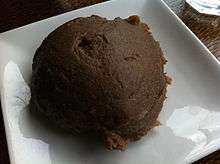Amala (food)
Àmàlà is a local indigenous Nigerian food, native to the Yoruba ethnic group in the western states of the country. It is made out of yam and/or cassava flour, or unripe plantain flour.[1] Yams are peeled, sliced, cleaned, dried and then blended into a flour, also called elubo. Yams are white in colour but turn brown when dried. This gives àmàlà its colour.[2][3] Àmàlà is from Western Africa and eaten mostly by the Yoruba people in Nigeria. Amala is mainly consumed by indigenous people of the Southwestern part of Nigeria.[4] It could be served with a variety of ọbẹ (soups), such as ẹfọ, ilá, ewédú, ogbono or gbegiri (black-eyed beans soup).[5]

Types
There are three types of àmàlà: àmàlà isu, àmàlà láfún and "amala ogede"
Yam flour (àmàlà isu)
This is the most common type of àmàlà which is derived from yam. The particular yam specie best for preparing àmàlà is Dioscorea cayenensis because of its high starch content. Yam, the common name for species in the genus Dioscorea, grows in Africa, Asia, the Caribbean, Oceania, and Latin America.[6] However, 95% of it is cultivated and harvested in West Africa. Yam is consumed in many different forms including boiled, roasted, baked, fried and conversion into flours. The perishability nature of yam due to its high moisture content suggests the need to process it into less perishable products such as yam flour through drying process. The flour can be reconstituted with hot water to form a paste or gel called Kokonte in Ghana and "Amala'' in Nigeria.[7] Àmàlà isu is made of dried yam. This gives it a black/brownish colour when added to boiling water. Amala is rich in carbohydrates owning to the fact that yam is an important source of carbohydrate for many people of the Sub Saharan region especially in the yam zone of west Africa.[8]
Cassava flour (àmàlà láfún)
The second type is àmàlà láfún, made from cassava flour. Dried cassava flour is known as “lafun” in
Nigeria and “kokente” in Ghana. Cassava is a woody shrub of the Euphorbiaceae (spurge) family. Cassava and yam are the most important source of food carbohydrate in Nigeria. Nigeria is the world's largest producer of cassava. Cassava flour, when used as a dry powder makes àmàlà láfún. Fermented and flaky, it is called Garri, another common dish, most often eaten by the Ijebu people.
Plantain flour (Amala ogede)
Another type of Amala is elubo ogede (which is usually lighter in color). The low carbohydrate level in plantain flour makes it a good diet for people diagnosed of diabetics and others who need a low-carbohydrate food. Unripe plantain is peeled, dried, and grated into boiling water to become amala ogede, light brown in colour when cooked.
Preparation
The only ingredient needed when making àmàlà is boiling water and one of the desired types of flour. Once the water has come to a boil, the heat is reduced. The flour is added and stirred until all the water is absorbed. More hot water is added, then the dough is left to simmer for approximately five minutes.[9] Then the dough is kneaded until it has the desired texture. Kneading the dough into a smooth paste is the most difficult part of making àmàlà.
Diverse Soups for the Dish
Àmàlà can be eaten with various soups:
- Egusi: soup made of thickened melon seeds and leaf vegetables
- Ewedu soup[10]: made from cooked and grated Corchorus leaves with or without a small quantity of egusi and/or locust beans.
- Okro soup: made from okra
- Efo riro: made from vegetables and a mixture of meat, fish, etc.[11]
- Ogbono soup: made from ground ogbono seeds and a mixture of stock fish and locust beans added as garnish
- Gbegiri soup, made from dried beans
See also
References
- Ferris, R. S. B.; Uwaegbute A. C.; Osho S. M.; Obatolu V. A. (1995). "Acceptability and chemical evaluation of fortified yam (Discorea spp.) products". Postharvest Technology and Commodity Marketing: Proceedings of a Postharvest Conference 2 Nov. To 1 Dec. 1995. Accra, Ghana: 172. ISBN 978-978-131-111-6.
- Balogh, Esther (1989). "History and perspectives of stable foods in Africa". Oxford Symposium on Food & Cookery. p. 51.
- Dumont, Roland (2006). Biodiversity and Domestication of Yams in West Africa: Traditional Practices Leading to Dioscorea Rotundata Poir. Editions Quae. p. 28. ISBN 9782876146327.
- Roots, Tubers, Plantains and Bananas in Human Nutrition. Rome: Food and Agriculture Organization of the United Nations. 1990. p. 68. ISBN 9789251028629.
- "How to Prepare Okro Soup (Obe ila)". Habeeb Olonje. 2018-09-05. Retrieved 2019-06-03.
- Ihekoronye, A. I., and Ngoddy, P. O. (1985). Integrated Food Science and Technology for the Tropics. London: Macmillan. pp. 293 & 391. ISBN 0333388836.CS1 maint: multiple names: authors list (link)
- Jimoh, .O., and Olatidoye, O. P. (2009). "Evaluation of physicochemical and theological characteristics of soybean fortified yam flour". Journal of Applied Biosciences. 13: 703–704 – via Researchgate.CS1 maint: multiple names: authors list (link)
- Akissoe, N. H., Hounhouigan, J. D., Brica, .W., Vernier, .P., Nago, .M. C., and Olorunda, O. A. (2003). "Physical, chemical and sensory evaluation of dried yam (Dioscorea rotundata) tubers, flour and amala- a flour-derived product". Journal of Tropical Science. 41: 151–156 – via Google Scholar.CS1 maint: multiple names: authors list (link)
- Badiru, I. & Badiru, D. (2013). Isi Cookbook: Collection of Easy Nigerian Recipes. Bloomington: iUniverse. p. 23. ISBN 9781475976717.
- Ngr, Information (2019-06-18). "How To Cook the Perfect Amala and Ewedu Soup". Information Nigeria. Retrieved 2019-11-02.
- Rees, D.; Farell, G. & Orchard, J. (2012). Crop Post-Harvest: Science and Technology, Perishables. Hoboken: John Wiley & Sons. p. 408.